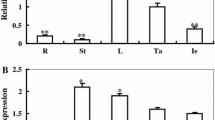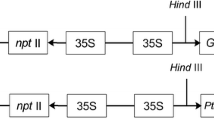Abstract
Glutathione S-transferases belong to a large ancient gene family and are thought to be one of the effective detoxification systems. To elucidate the function of the gene in poplar, a tau class gst gene (PatgGSTU51) was cloned from poplar cell suspension cDNA library and its expression was examined. The gene was not expressed in normal conditions, but significantly induced by toxic heavy metals like cadmium and inorganic mercury. However, the highest expression was observed when treated with its synthetic substrate, 1-chloro-2,4-dinitrobenzene (CDNB). Several transgenic poplar lines harboring a chimeric p35S-PatgGSTU51 were developed to understand its function in plant defense. Real-time quantitative PCR, western blot and cellular GST activities consistently showed the transgene was highly expressed in the transgenic lines. The transgenic lines showed increased tolerance to methyl viologen as well as to inorganic mercury but not to cadmium. Furthermore, they did not show any significant tolerance against CDNB, the electrophilic substrate of GST isozymes. Thus, the results suggest that, although PatgGSTU51 is induced by a number of stress agents, it confers a selective tolerance to the toxicity of heavy metal mercury over those of other stress agents and also to oxidation stress caused by MV. Tolerance to CDNB that induces the gene to high level may require such an extra supplemental gene action as vacuolar sequestration.








Similar content being viewed by others
References
Agrawal GK, Jwa NS, Rakwal R (2002) A pathogen-induced novel rice (Oryza sativa L.) gene encodes a putative protein homologous to type II glutathione S-transferases. Plant Sci 163:1153–1160
Bradford MM (1976) A rapid and sensitive method for the quantitation microgram quantities of protein utilizing principle of protein-dye binding. Anal Biochem 72:248–254
Choi YI, Noh EW, Lee HS, Han MS, Lee JS, Choi KS (2005) An efficient and novel plant-selectable marker based on organomercurial resistance. J Plant Biol 48:351–355
Dixon DP, Davis BG, Edwards R (2002) Functional divergence in the glutathione transferase superfamily in plants: identification of two classes with putative functions in redox homeostasis in Arabidopsis thaliana. J Biol Chem 277:30859–30869
Edwards R, Dixon DP, Walbot V (2000) Plant glutathione S-transferases: enzymes with multiple functions in sickness and in health. Trends Plant Sci 5:193–198
Felsenstein J (1985) Confidence limits on phylogenies: an approach using the bootstrap. Evolution 39:783–791
Fillatti JJ, Sellmer J, McCown B, Hassig B, Comai L (1987) Agrobacterium mediated transformation and regeneration of poplars. Mol Gen Genet 206:192–199
Foyer CH, Descourvieres P, Kunert KJ (1994) Protection against radicals: an important defense mechanism studied in transgenic plants. Plant Cell Environ 17:507–523
Gallagher ER, Sheehy KM, Lame MW, Segal HJ (2000) In vitro kinetics of hepatic glutathione S–transferase conjugation in largemouth bass and brown bullheads. Environ Toxicol Chem 19:319–326
Gong H, Jiao Y, Hu WW, Pua EC (2005) Expression of glutathione S-transferase and its role in plant growth and development in vivo and shoot morphogenesis in vitro. Plan Mol Biol 57:53–66
Griffith OW (1980) Determination of glutathione and glutathione disulfide using glutathione reductase and 2-vinylpyridine. Anal Biochem 106:207–212
Grill E, Lffler S, Winnacker E-L, Zenk MH (1989) Phytochelatins, the heavy-metal binding peptides of plants, are synthesized from glutathione by a specific-y-glutamylcysteine dipeptidyl transpeptidase (phytochelatin synthase). Proc Natl Acad Sci USA 86:6838–6842
Gullner G, Kömives T, Rennenberg H (2001) Enhanced tolerance transgenic poplar plants overexpressing γ-glutamylcysteine synthetase towards chloroacetanilide herbicides. J Exp Bot 52:971–979
Hasanuzzanan M, Hossain MA, da Silva Ja.T., Fujita M. (2012) Plant response and tolerance to abiotic oxidative stress: antioxidant defense is a key factor. In: Venkateswarlu B, Shanker AK, Shanker C, Maheswari M (eds) Crop stress and its perspectives and strategies. Springer, Dordrecht
Kampranis SC, Damianova R, Atallah M, Toby G, Kondi G, Tsichlis PN, Makris AM (2000) A novel plant glutathione S-transferase/peroxidase suppresses Bax lethality in yeast. J Biol Chem 275:29207–29216
Koh EJ, Song WY, Lee YS, Kim KH, Kim KD, Chung NH, Lee KW, Hong SW, Lee HJ (2006) Expression of yeast cadmium factor 1 (YCF1) confers salt tolerance to Arabidopsis thaliana. Plant Sci 170:534–541
Laemmli UK (1970) Cleavage of structural proteins during the assembly of the head of bacteriophage T4. Nature 227:680–685
Lan T, Yang ZL, Yang X, Liu YJ, Wang XR, Zeng QY (2009) Extensive functional diversification of the Populus glutathione S-transferase supergene family. Plant Cell 21:3749–3766
Lee H, Lee JS, Noh EW, Bae EK, Choi YI, Han MS (2005) Generation and analysis of expressed sequence tags from poplar (Populus alba × P. tremula var. glandulosa) suspension cells. Plant Sci 169:1118–1124
Li Z-H, Lu Y-P, Zhen R-G, Szczypka M, Thiele DJ, Rea PA (1997) A new pathway for vacuolar cadmium sequestration in Saccharomyces cerevisiae: YCF1-catalyzed transport of bis(glutathionato)cadmium. Proc Natl Acad Sci USA 94:42–47
Lloyd G, McCown BH (1981) Commercially feasible micropropagation of mountain Laurel, Kalmia latifolia, by use of shoot tip culture. Proc Int Plant Prop Soc 30:421–427
Loyall L, Uchida K, Braun S, Furuya M, Frohnmeyer H (2000) Glutathione and a UV light-induced glutathione S-transferase are involved in signaling to chalcone synthase in cell cultures. Plant Cell 12:1939–1950
Lu Y-P, Li Z-S, Rea P-A (1997) AtMRP1 gene of Arabidopsis encodes a glutathione S-conjugate pump: isolation and functional definition of a plant ATP-binding cassette transporter gene. Proc Natl Acad Sci USA 94:8243–8248
Martinoia E, Grill E, Tommasini R, Kreuz K, Amrhein N (1993) An ATP dependent glutathione S-conjugate “export” pump in the vacuolar membrane of plants. Nature 364:247–249
Meyer AJ, Fricker MD (2002) Control of demand-driven biosynthesis of glutathione in green Arabidopsis suspension culture cells. Plant Physiol 130:1927–1937
Moons A (2005) Regulatory and functional interactions of plant growth regulators and plant glutathione S-transferases (GSTs). Vitam Horm 72:155–202
Mueller LA, Goodman CD, Silady RA, Walbot V (2000) AN9, a petunia glutathione S-transferase required for anthocyanin sequestration, is a flavonoid-binding protein. Plant Physiol 123:1561–1570
Murashige T, Skoog F (1962) A revised medium for rapid growth and bioassays with tobacco tissue culture. Physiol Plant 15:473–497
Roxas VP, Lodhi SA, Garrett DK, Mahan JR, Allen RD (2000) Stress tolerance in transgenic tobacco seedlings that over-express glutathione S-transferase/glutathione peroxidase. Plant Cell Physiol 41:1229–1234
Sharma SS, Dietzs K-J (2009) The relationship between metal toxicity and cellular redox imbalance. Trends Plant Sci 14:43–50
Smith AP, DeRidder BP, Guo WJ, Seeley EH, Regnier FE, Goldsbrough PB (2004) Proteomic analysis of Arabidopsis glutathione S-transferases from benoxacor- and copper-treated seedlings. J Biol Chem 279:26098–26104
Sneath PHA, Sokal RR (1973) Numerical taxonomy: the principles and practice of numerical classification. Freeman, San Francisco
Soranzo N, Sari Gorla M, Mizzi L, De Toma G, Frova C (2004) Organisation and structural evolution of the rice glutathione S-transferase gene family. Mol Genet Genomics 271:511–521
Stoop JMH, Pharr DM (1994) Mannitol metabolism in celery stressed by excess macronutrients. Plant Physiol 106:503–511
Tamura K, Dudley J, Nei M, Kumar S (2007) MEGA4: molecular evolutionary genetics analysis (MEGA) software version 4.0. Mol Biol Evol 24:1596–1599
Taylor G (2002) Populus: Arabidopsis for forestry: do we need a model tree? Ann Bot 90:681–689
Tuscan GA, DiFazio S, Jansson S (2006) The genome of black cottonwood, Populus trichocarpa (Torr & Gray). Science 313:1596–1604
Xiang C, Werner BL, Christensen EM, Oliver DJ (2001) The biological functions of glutathione revisited in Arabidopsis transgenic plants with altered glutathione levels. Plant Physiol 126:564–574
Yu T, Li YS, Chen XF, Hu J, Chang X, Zhu YG (2003) Transgenic tobacco plants over-expressing cotton glutathione S-transferase (GST) show enhanced resistance to methyl viologen. J Plant Physiol 160:1305–1311
Zuckerkandl E, Pauling L (1965) Evolutionary divergence and convergence in proteins. In: Bryson V, Vogel HJ (eds) Evolving genes and proteins. Academic, New York, pp 97–166
Acknowledgments
This project was funded by Korea Forest Research Institute, Project FG0702-2002-01.
Author information
Authors and Affiliations
Corresponding author
Rights and permissions
About this article
Cite this article
Choi, Y.I., Noh, E.W., Kim, H.J. et al. Overexpression of poplar GSTU51 confers selective tolerance to both mercury and methyl viologen but not to CDNB or cadmium in transgenic poplars. Plant Biotechnol Rep 7, 175–184 (2013). https://doi.org/10.1007/s11816-012-0246-z
Received:
Accepted:
Published:
Issue Date:
DOI: https://doi.org/10.1007/s11816-012-0246-z




